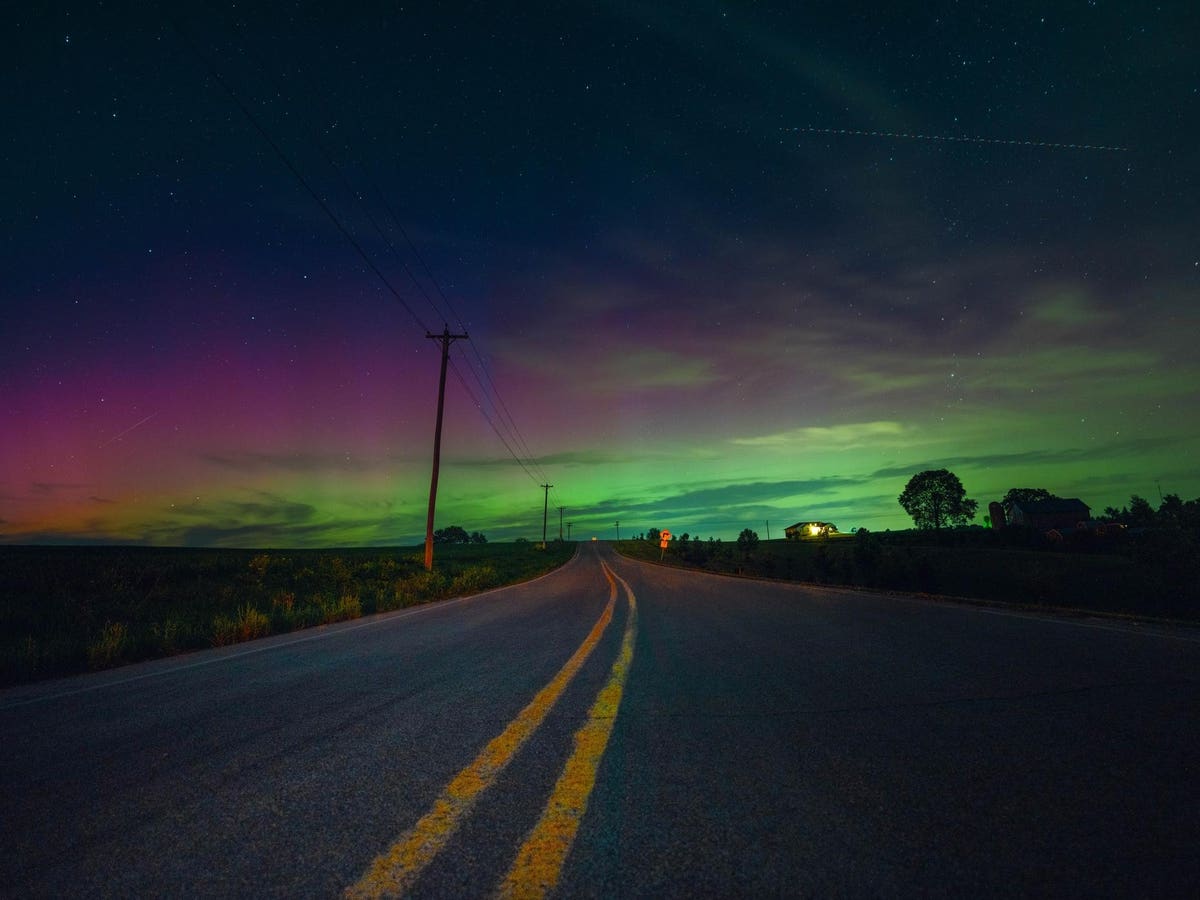Wisconsin’s night sky is glowing with the Northern Lights, as a geomagnetic storm is bringing vibrant pink and green colors, stealing the spotlight from the Perseus meteor shower. (Photo by Ross Harried/NurPhoto via Getty Images)
NurPhoto via Getty Images
Sky-watchers across the northern U.S. could be treated to a fresh display of the Northern Lights after dark on Tuesday, Oct. 7, as two coronal mass ejections from the sun interact with Earth’s magnetic field to cause a G1 or possibly G2-rated geomagnetic storm.
The pair of solar storms is expected to bring an increased chance of geomagnetic activity and auroras at high and possibly mid-latitudes, according to NOAA’s Space Weather Prediction Center.
Although a bright full harvest moon on Oct. 6 will mean a bright moon rising after dark to wash out fainter auroras, any strong geomagnetic activity could still produce visible color on the northern horizon.
Northern Lights Forecast: What To Expect
Two slow-moving CMEs — clouds of charged particles ejected from the sun — launched on Friday, Oct. 3, and have been producing auroras for the past few nights. They’ll likely reinforce the solar wind already buffeting Earth’s magnetic field.
“Geomagnetic field activity will likely reach G1 (Minor) storm levels, with a chance for G2 (Moderate) periods, on 07 and 08 Oct due to CME effects,” reads an update from NOAA. “Primarily unsettled conditions are expected on Oct. 9 as CME effects slowly wane.”
Northern Lights Forecast: Where To Watch
There’s a chance of G1 or even G2-class storms as the CMEs arrive. If activity reaches those levels, auroras could be visible low on the northern horizon across 12 U.S. states: Alaska, and northern parts of Washington, Idaho, Montana, Wyoming, North Dakota, South Dakota, Minnesota, Wisconsin, Michigan, New York, and Maine.
To maximize your chances, look north after dark, though with the moon so bright, driving into dark rural skies is not crucial.
NOAA’s aurora viewline for Tuesday, Oct. 7, 2025.
NOAA
Northern Lights Tonight: Latest Forecast
Geomagnetic activity is hard to predict. For the latest data, check real-time aurora and solar wind data via NOAA’s 30-minute forecast or apps like My Aurora Forecast and Glendale Aurora.
Although the Kp index is what aurora-chasers tend to fixate upon, the critical variable is the interplanetary magnetic field (Bz). If it turns southward, the door opens for auroral energy to flood into Earth’s atmosphere — often within minutes. Data on the Bz direction can be tracked on sites such as SpaceWeatherLive.com.
Northern Lights Forecast: ‘Equinox Effect’
Early October often brings surprisingly frequent and strong displays of aurora — and there’s a reason for that. In the wake of the equinoxes in March and September, Earth’s magnetic field tilts into a more favorable orientation, allowing solar particles to interact more effectively with the magnetosphere.
It’s called the Russell-McPherron effect — named after a couple of researchers who published a paper in the 1970s — and it significantly increases the likelihood of geomagnetic storms. When the sun’s magnetic field turns southward, it links directly with Earth’s field, opening a pathway for energetic solar particles to enter the upper atmosphere. As those particles collide with oxygen and nitrogen atoms, they excite them into glowing — creating the green, purple, and red ribbons of light we recognize as the Northern Lights.
That equinox effect often comes with a lag, with early October one of the best windows for auroral storms at mid-northern latitudes.
How To Photograph The Northern Lights
Moonlight may make faint aurora harder to see, but cameras will pick it up. A mirrorless or DSLR camera is ideal, but many newer smartphones can capture stunning aurora shots using Night Mode.
- Use your main camera lens, not the ultra-wide.
- Steady your device with a tripod or solid surface to avoid blur.
- If possible, shoot in RAW format for easier post-editing.
- Expect exposure times of 5-10 seconds — long enough to reveal color and detail invisible to the eye.
Even faint auroras can photograph beautifully, so don’t be discouraged if your eyes see only a pale glow.
What Causes the Northern Lights
The aurora is the visible expression of space weather — the interaction between the solar wind and Earth’s magnetic field. Most of the solar wind is deflected, but when CMEs or high-speed streams strike Earth’s magnetosphere, charged particles follow magnetic field lines toward the poles. Collisions with oxygen and nitrogen atoms in the upper atmosphere produce the characteristic colors: green from oxygen, and purple or red from nitrogen.
Wishing you clear skies and wide eyes.









